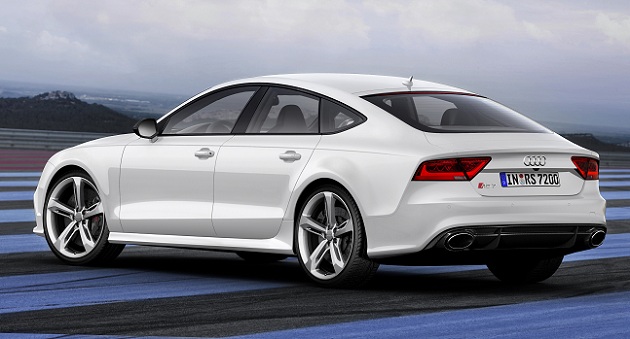
Audi is expanding its RS model lineup: The RS 7 Sportback, which is making its debut at the North American International Auto Show 2013 in Detroit, stands for dynamics at their most beautiful. The large five-door coupe uses a 4.0 TFSI engine producing 412 kW (560 hp). The sprint from zero to 100 km/h (62.14 mph) takes just 3.9 seconds, and the speed governor can be deactivated upon customer request to permit a top speed of up to 305 km/h (189.52 mph). Despite this superior performance, the Audi RS 7 Sportback consumes on average just 9.8 liters of fuel per 100 km (24.00 US mpg).
Available to order in the summer of 2013 priced in the region of £84,000 OTR, and due in the UK towards the end of the year, the RS 7 Sportback shares its 4.0-litre V8 TFSI engine with the recently announced RS 6 Avant. This means that with the help of its two turbochargers formidable peak power of 560PS arrives between 5,700 and 6,700 rpm, and peak torque of 700 Nm is constantly available between 1,750 and 5,500 rpm.
The two large twin-scroll turbochargers located, along with the intercooler, inside the ‘V’ of the cylinder banks, produce up to 1.2 bar of boost pressure, helping to generate incredible accelerative force. The RS-specific engine management and unthrottled intake system also contribute to the engine’s dramatic response, and this is delivered with all the charisma expected of a V8. Switchable flaps in the exhaust system can make the sound even fuller at the touch of a button, and customers seeking an even more dramatic drive can choose a sports exhaust system from the options list.
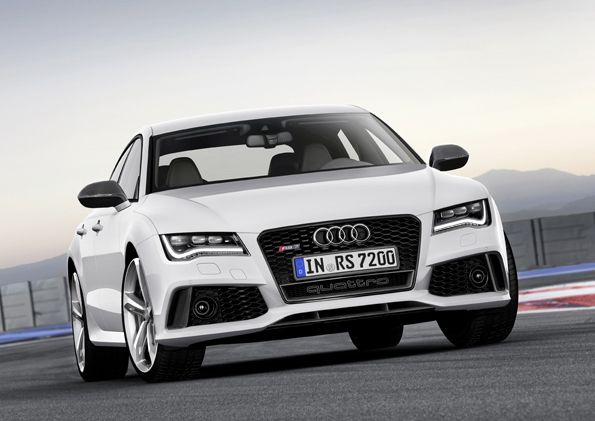
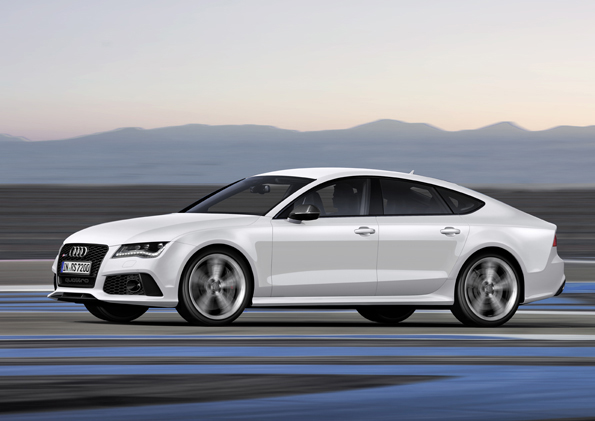
Variable top speed
‘Standard specification’ in performance terms for the new RS 7 Sportback – although anything but standard – is a phenomenal 0-62mph acceleration time of just 3.9 seconds and a governed 155mph top speed. Customers with Autobahn aspirations can increase the latter to 174mph by specifying the optional Dynamic package, and boost it even further still with the Dynamic plus package, which calls a halt to acceleration at 189mph.
Despite performance of this magnitude, the RS 7 Sportback nevertheless manages to maintain a firm grasp on reality where economy is concerned. Thanks partly to an engine start-stop system and innovative thermal management technology, but primarily to the new engine’s cylinder on demand (COD) system, it can cover up to 28.8mpg according to the combined cycle test. At low to intermediate loads and engine speeds, the cylinder-on-demand system shuts down the intake and exhaust valves of cylinders 2, 3, 5 and 8. The engine then runs as a four-cylinder until the driver demands strong accleration. Efficiency in the active cylinders is increased because the operating points are displaced toward higher loads.
The switch between four and eight-cylinder operation takes just a few hundredths of a second, and the only real indication to the driver that it is taking place is a visual signal within the instrument cluster. The COD technology reduces ECE fuel consumption by roughly five per cent. Even greater savings of approximately 10 per cent are possible when driving at moderate speeds. Active engine mounts use out-of-phase counter-oscillations to compensate for the vibrations that occur during four-cylinder operation.
The 4.0-litre TFSI is paired with the familiar, and highly favoured, eight-speed tiptronic transmission featuring shortened shift times and offering ‘Sport’ and ‘Manual’ modes in addition to the standard ‘Drive’ setting. For manual shifts drivers can use the paddles on the steering wheel or the RS-specific selector lever. The lower gears of the tiptronic are tightly spaced for optimum performance, while a tall eighth gear reduces fuel consumption.
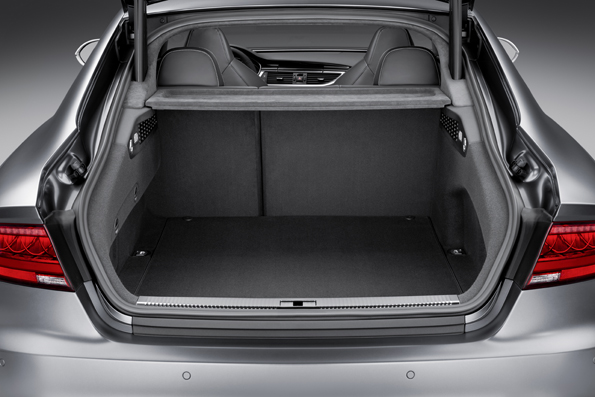
In the RS 7 Sportback the quattro permanent all-wheel drive system which is one of the hallmarks of the RS lineage incorporates torque vectoring, a self-locking centre differential with an elevated locking value and a sport differential on the rear axle to distribute power steplessly between the rear wheels.
RS 7 adaptive air suspension
The unparalleled controllability the quattro system imparts is complemented in the RS 7 Sportback by impressive ride refinement which comes courtesy of adaptive air suspension with RS-specific settings. The specially tuned set-up lowers the body by 20 millimetres, and incorporates damping with configurable settings. As an alternative, sports suspension plus with Dynamic Ride Control (DRC) will also be available. This system employs steel springs and three-way adjustable shock absorbers that are interconnected diagonally by means of oil lines and a central valve for improved body roll stability.
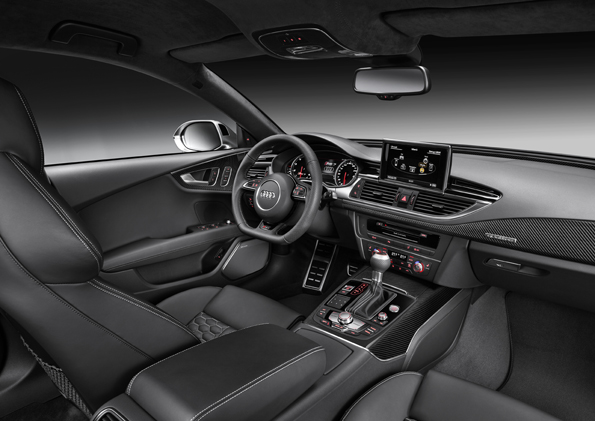
Both set-ups are controllable via the Audi drive select adaptive dynamics system, which enables the driver to choose between Comfort or Dynamic modes depending on their preference, or an Automatic mode in which sensors automatically adjust the settings based on driving style, speed and prevailing conditions. An Individual mode is also available in which the driver can assign one of these three settings to each individual component of the driving experience, from the suspension or steering weighting to the throttle response and the sport differential. It will also be possible to further enhance the adaptability of the steering by choosing the extra cost dynamic steering option, which allows the driver to steplessly vary the actual ratio and boost and can also be controlled via the Audi drive select system.
The exceptional performance and handling calls for brakes of the first order, and in the RS 7 Sportback the four internally vented discs with their weight-saving wave-like outer contour more than meet the brief. The front discs measure 390 millimetres in diameter and are gripped by six-piston calipers which are available in either black or red. Also available as an option are carbon fibre-ceramic brake discs with anthracite grey calipers which measure 420 millimetres in diameter.
Polished 20-inch alloy wheels in a seven twin-spoke design will be standard for UK RS 7 Sportback models, and three 21-inch cast wheels will be available at extra cost.
20 per cent aluminium
The body plays a major role not only in the handling, but also in heightening the sense of refinement and precision engineering the RS 7 Sportback exudes. It comprises roughly 20 per cent aluminium, and a sizeable proportion of components made from high-strength steel, and is notable for its outstanding rigidity.
Numerous RS-specific design details subtly embellish the body without detracting from its elegantly tapering lines. Most noticeable are the matt titanium applications, the high gloss black honeycomb radiator grille, exclusive bumper design and, at the rear, a diffuser and two large, elliptical exhaust tailpipes. In common with the other members of the A7 Sportback range, the RS 7 Sportback is also pinned more securely to the road by an electrically extending rear spoiler providing additional downforce.
Nine exterior colours, including the new Nardo Grey and the exclusive Daytona Grey matte, will be available, along with two optional exterior design packages – Matt Aluminium or Carbon – which give the RS 7 Sportback an even more distinctive stance.
The interior of the RS 7 Sportback conveys the sporting theme with similar subtlety, but leaves passengers in no doubt that they are travelling in a very special Audi flagship. RS logos appear in the dials with their black faces, white dials and red needles, on the flat-bottomed three-spoke multifunction steering wheel, in the illuminated entry sills, in the rev counter and in the displays for the MMI and the colour Driver’s Information System (DIS). They are also punched into the front RS super sports seats with their pronounced bolsters, integrated head rests and honeycomb-quilted Valcona leather upholstery. The two-seat rear bench also has pronounced contours for optimum grip. A combination of Alcantara and leather can be specified as a no-cost alternative upholstery option, and power-adjustable front comfort seats can also be added at extra cost to replace the more overtly sporting RS originals.
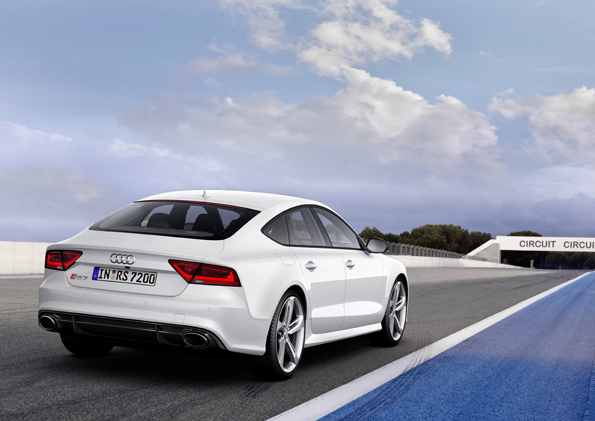
New shift light feature
A new feature in the RS menu of the DIS is the shift light. Green segments are illuminated as revs increase. The bar turns red and begins to blink when revs approach the red line. Displays for the gear selected, boost pressure, oil temperature and a digital speedometer round out the RS 7-specific driver information system.
The footrest, pedals and switches in the MMI navigation plus terminal have an aluminium look which contrasts with the piano finish for the decorative bezel surrounding the retractable monitor and the carbon inlays. A black headlining is standard, but Moon Silver or black Alcantara options are also available.
As befits the ultimate incarnation of the A7 Sportback, the RS 7 will feature a generous list of standard equipment, and it will be possible to upgrade this list even further with a portfolio of exceptional driver assistance, driver entertainment and driver information systems, including adaptive cruise control, night vision, the Bang & Olufsen Advanced Sound System with 15 speakers and 1,200 watts of total power and mobile phone preparation – High with Audi connect, bringing web-based services to the car.
Colors and materials provide for further differentiation. The footrest, pedals and soft keys in the standard MMI navigation plus terminal shine in an aluminum-look finish. The decorative trim below the retractable monitor sports a piano finish.
Carbon inlays are standard, with four additional materials available as options. The headlining comes standard in black cloth, with options for lunar silver or black Alcantara. Of course, the Audi RS 7 Sportback can also be personalized using the Audi exclusive program.
RS sport seats with pronounced side bolsters, integrated head restraints and RS 7 logos are standard. They are covered in a combination of black Alcantara and leather, and the center sections feature diamond quilting. The seats can also be covered alternatively in high-grade, honeycomb-quilted Valcona leather in either black or lunar silver. Audi offers optional power-adjustable comfort seats with memory function. The two rear seats are powerfully contoured. Luggage capacity ranges from 535 to 1,390 liters (18.89 to 49.09 cu ft) depending on the position of the rear seat backs.
The Audi RS 7 Sportback comes with a generous list of standard equipment, including xenon plus headlights, a tire pressure monitoring system, the parking system plus, three-zone automatic air conditioning, cruise control and the Audi sound system in addition to features mentioned previously. High-end options include a head-up display, a comfort package, the dynamic package and the dynamic package plus.
The Bluetooth online car phone is an ideal complement to the standard MMI navigation plus. Its UMTS module delivers the tailored Audi connect services to the on-board monitor, and a WLAN hotspot connects the passengers’ mobile devices. Topping the range of audio modules is the Advanced Sound System from Bang & Olufsen.
The Audi RS 7 Sportback also leads the pack when it comes to driver assistance systems. One of these is the adaptive cruise control with stop & go function including Audi pre sense front. This keeps the powerful coupe at the proper distance from the car ahead and in many situations can help to avoid accidents or mitigate their consequences.
Audi active lane assist helps the driver to keep the RS 7 Sportback on course. The park assist handles the steering when parking. The night vision assistant with highlighting of detected persons reduces the stress of driving in the dark. Audi side assist and the speed limit display round out the list.
Picture caption
The most sporting Audi sportback of all – The new Audi RS 7 Sportback makes its debut in Detroit this week combining sub-four-second 0-62mph acceleration, a top speed of up to 189mph and the potential for up to 28.8mpg.
In 2012 Audi recorded its best ever worldwide result of 1,455,100 sales, an 11.7 per cent improvement over 2011. Of these, 123,622 are attributable to the UK, an 8.6 per cent increase on 2011, and another record. To remain true to its Vorsprung durch Technik philosophy, the brand plans to invest €13 billion, mainly in new products, between now and 2015. By this point, its range will have expanded to well in excess of 42 models. Recent additions, including the all-new A3 and A3 Sportback, the S6, S7 Sportback and S8 and the RS 4 Avant, will be joined imminently by the new generation R8 and the RS 6 Avant. On the race circuit, Audi has competed in the Le Mans 24 Hour sportscar endurance race 14 times since 1999, achieving a podium finish on all of these occasions as well as outright victory 11 times. In 2012, Audi made history at Le Mans by winning with pioneering hybrid diesel technology used in the Audi R18 e-tron quattro.










